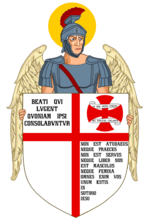Etrurian First Republic: Difference between revisions
| Line 174: | Line 174: | ||
=== La Purga === | === La Purga === | ||
* Pantheonisti stage a coup, capturing, exiling or killing the Rispettabili | |||
* Pantheonisti assumed complete control of the Popular Convention and begin building a loyalist base within the republican armies. | |||
* Secures the backing of the Archbishop of Tyrrenhus and the Principality's clergy (overwhelming majority) | |||
==== Devotion of the Republic to Heaven ==== | ==== Devotion of the Republic to Heaven ==== | ||
[[File:Serment du Jeu de Paume - Jacques-Louis David.jpg|290px|thumb|left|The Devotion of the Republic by [[Andrea Simone Calatrava]], 1795.]] | [[File:Serment du Jeu de Paume - Jacques-Louis David.jpg|290px|thumb|left|The Devotion of the Republic by [[Andrea Simone Calatrava]], 1795.]] | ||
* The Pantheonisti devote the republic to Heaven and vow to instil their ideological tenets. | |||
* First Bonfire of the Heresies is launched, destroying brothels, gambling dens and coffee houses used by the upper-classes. | |||
* War of the League begins with Carinthia, Novalia and the northern states invading Tyrrenhus. | |||
=== War of the Leagues === | === War of the Leagues === | ||
Revision as of 03:35, 14 December 2021
Etrurian Republic Republic of Heaven Reppublica Etruriana Repubblica del Cielo | |
|---|---|
Motto:
| |
Anthem:
| |
| Capital | Tyrrenhus (1784-1787) Solaria (1787-1810) |
| Religion | Solarian Catholicism |
| Demonym(s) | Etrurian |
| Government | Directorial republic (1784-1785) Theo-directorial republic (1785-1810) |
| President of the Convention | |
• 1784 | Aurelio Polizzi |
| Member of the Aventine Triad | |
• 1784-1785 | Francesco Cassio Caciarelli |
• 1784-1785 | Massimiliano Malaspina |
• 1784-1785 | Giovanni-Paolo Danova |
| First Citizen | |
• 1785-1810 | Francesco Cassio Caciarelli |
| Legislature | Senate of the Republic |
| History | |
• Established | 20 January 1784 |
| 9 September 1783 | |
| 3 November 1783 | |
| 20 January 1784 | |
| 10 July 1784 | |
• La Purga | 18 July 1784 |
| 20 July 1784 | |
| 12 August 1810 | |
| Population | |
• 1784 | 18,398,200 |
• 1810 | 19,998,200 |
| Currency | Etrurian piastra |
| Today part of | Etruria Gaullica Piraea Galenia |
The Etrurian First Republic (Prima Repubblica Etruriana), officially known as the Etrurian Republic (Repubblica Etruriana) and co-officially known as the Republic of Heaven (Repubblica del Cielo), was founded on 20 September 1784, during the Etrurian Revolution. The First Republic would end with the Caltrini Restoration on 18 August 1810. Throughout most of its existence, the First Republic was governed by the Pantheonisti faction, under a theocratic directorial republican system. The period of the First Republic was characterised by the overthrow of the Grand Principality of Tyrrenhus, the establishment of the Popular Convention, the Aventine Triad, the Pantheonisti led La Purga, its subsequent domination, the Republic of Heaven period, the Revolutionary Wars, La Tempesta and finally, its demise with the Caltrini Reactions and the Caltrini Restoration.
Though the initial revolution within Tyrrenhus established the Popular Convention, infighting between the three principal factions over the direction of the newly formed Republic would escalate into the La Purga, a violent coup d’état instigated by the Pantheonisti. This group, defined by its esoteric mixing of enlightenment ideals and Catholicism immediately issued the Devotion of the Republic to Heaven, which instilled their ideals in the nascent Republic. This was followed by various Bonfires, with each constituting the targeting of a specific culture or supposed threat to the Republic.
Almost instantly in wake of the La Purga, the Republic found itself at war with its fellow Etrurian states, in what became known as the War of the League. The Kingdoms of Novalia and Carinthia together with the Duchies of Dinara and Peravia dispatched armies to restore the Principality, they were successively defeated by the Republic and suffered counter-invasion, resulting in the collapse and annexation of Carinthia and Novalia by 1786. In 1787, the War of the Northern League began, with the recently re-proclaimed Etrurian Republic launching invasions of Carvagna, Torrazzia and Povelia, annexing them with little to no resistance. Fighting between the Republic and the two northern Duchies ended with their annexation in 1789. This was followed from 1790 onward with numerous wars against Etruria’s neighbours, including Paretia and Gaullica. In one of the most pivotal moments in Eastern Euclean history, in 1789, republican armies invaded and occupied Solaria, with the aim of forcing the support of Pope Alexander XVIII, who however, fled to Gaullica. Solaria was duly proclaimed the capital of the Republic, restoring the city as the capital of a united Etruria for the first time since the Solarian Empire’s demise in 475.
During its existence, the Etrurian First Republic instituted numerous reforms. These included the introduction of universal suffrage for men and women aged 21 and over, the abolition of slavery, equality before law, communal property, the banning of interest rates and introduction of debt forgiveness and a codified law system, while a highly modified version of Werania’s Code of the Rights of Man was enforced through law. However, the Republic due to its own paranoia and state promoted mass violence also took to more radical decisions, such as the attempted effort to abolish currency and restore a bartering based economy, price controls and the enforcement of the Declaration of Rights of State, which proscribed the state’s right to use violence against its population. The most contentious issue of the First Republic was its formulation of the Canon of Heaven’s Devotions, a document which served to encapsulate the ideology of the revolution.
Throughout the 1790s, the Republic scored major victories against its royalist enemies. Its capable officer corps, including Giorlamo lodare-Dio Schiave, Augustino Cesare Santoro and Caio Teme-Dio Trellini and the expertly used Nobilis Hospes, providing the Republic with significant numbers of conscripts, all combined to enable the establishment of Ecumenical Republics in Paretia, Piraea, Amathia and Gaullica. However, economic mismanagement, zealotry and ever-increasing violence domestically began to undermine the Republic. Coupled with growing resistance by the Papacy to what it officially described as an “blasphemous and apostatic science”, popular support began to crumble. In 1802, the Weranian Republic collapsed, enabling the other major Euclean monarchies to aid Gaullica. From 1806 through to 1810, the exiled Etrurian aristocracies united around the House of Caltrini, who returned with a sizeable force in early 1810 and overthrew the Republic as the republican armies disintegrated.
The United Kingdom of Etruria was established several weeks later, though as a constitutional monarchy, rather than absolutist. The legacy of the Etrurian First Republic would live on through parliamentarianism, social welfarism, civic virtue enforced by law, egalitarianism, and a deference of state to the Church. The Republic’s wedding of Catholicism with republicanism and nationalism would play a prominent role within Etrurian society through to the 1880s, when the Caltrini monarchy was overthrown, and would leave marks on neighbouring Gaullica and Paretia.
The First Republic would leave a profound legacy in both Etruria and the wider world, ideologically, politically, economically and religiously. It united the territories of Etruria for the first time since Solarian times and would export its unique theocratic republicanism across much of Southern Euclea, leaving an indelible mark on the evolution of the Catholic Church. In comparison to its rival Weranic Republic, the Etrurian Republic’s ideals and principles of popular universal suffrage, utilitarianism, egalitarianism and a Catholicism-infused Etrurian nationalism, would live on almost a century through the clergy and academic circles, ultimately being reconstituted in some form with the Etrurian Second Republic, following the San Sepulchro Revolution in 1888 that overthrew the Caltrini monarchy.
History
Origin
- Grand Principality of Tyrrenhus is ruled incompetently by successive Grand Princes.
- Near two-decades of war between Tyrrenhus and Povelia over central Vespasia has bankrupted Tyrrenhus and become unpopular
- Successive agitation by clubs, societies and groups.
- Bread riots begin over a taxation on wheat
- Bread riots escalate
- March of the Widows, sees guards open fire on war widows demanding better pensions.
- Mass revolt and overthrow of the monarchy.
Popular Convention
- New national convention is established by former parliamentarians and the three prominent revolutionary groups.
- Groups; Rispettabili (gentleman revolutionaries + cult of reason types), Scugnizzo (radical poor, San Coulettes types), Pantheonisti (theo-republicans)
- Inter factional fighting and disagreements
- Grand Prince's execution
- Rising tensions between the Rispettabili and Pantheonisti over atheist and cult of reason
- Scugnizzo destroyed by Pantheonisti
La Purga
- Pantheonisti stage a coup, capturing, exiling or killing the Rispettabili
- Pantheonisti assumed complete control of the Popular Convention and begin building a loyalist base within the republican armies.
- Secures the backing of the Archbishop of Tyrrenhus and the Principality's clergy (overwhelming majority)
Devotion of the Republic to Heaven

- The Pantheonisti devote the republic to Heaven and vow to instil their ideological tenets.
- First Bonfire of the Heresies is launched, destroying brothels, gambling dens and coffee houses used by the upper-classes.
- War of the League begins with Carinthia, Novalia and the northern states invading Tyrrenhus.


